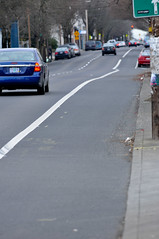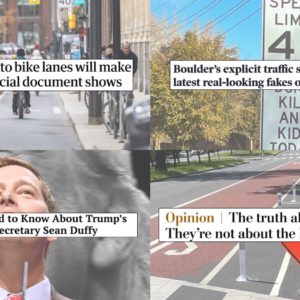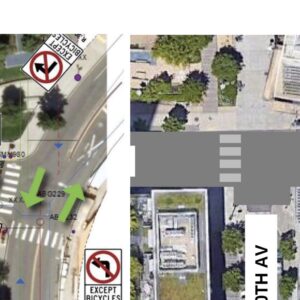When I first put forth the issue of cars parking in and completely blocking vehicle lanes reserved for bicycles (a.k.a. bike lanes), I didn’t expect to write two follow-ups about it. But I’ve gotten another interesting response from PBOT that is worth sharing.
Yesterday I shared a follow-up with a few insights gleaned from the helpful comments on the initial story as well as an explanation from PBOT about their enforcement policy.
At the end of yesterday’s story I wondered out loud whether or not more signage and markings from PBOT might be a good solution. Yesterday afternoon PBOT responded with an explanation of their engineering approach to the problem.
The 1996 Bike Master Plan called for bike lane pavement markings (the bike lane symbol) every 250 feet. That policy was amended in the 2030 Bike Plan to a bike lane symbol only being mandated every 1,000 feet — a cost-savings measure according to PBOT spokesperson Cheryl Kuck.
“While the 8-inch stripe is technically sufficient to enforce against parking in the bike lane, we know that some motorists don’t understand that and may be successful arguing their case with the court.”
— Cheryl Kuck, PBOT spokesperson
Kuck says PBOT expected that as a result of this new policy, there’d be locations where parking in the bicycle travel lane could become an issue. “While the 8-inch stripe is technically sufficient to enforce against parking in the bike lane,” Kuck wrote via email, “we know that some motorists don’t understand that and may be successful arguing their case with the court.” (Meaning, they’d get their tickets thrown out by the judge.)
In an effort to make this illegal parking stand up better in court (and thus make it more enforceable), Kuck says they decided to add additional markings and/or signage to specific locations when necessary.
Kuck described a collaboration between City Parking Enforcement officers, traffic engineers, and bicycle program staffers at PBOT. When officers see repeated violations at a particular location, they report it to PBOT, who then assesses if additional markings are needed.
Examples of locations where this tag-team effort has resulted in new markings include:
- NE Russell west of NE Rodney (near the Wonder Ballroom and Toro Bravo restaurant);
- NW 14th between NW Davis and NW Everett (to keep right-turning motorists out of the bike lane);
- SW Broadway in front of the Benson and the Heathman hotels (to prevent double-parking); and
- NE Rosa Parks Way (we’re currently investigating the need for markings in the bike lane near New Season’s Market).

Kuck says “No Parking” signage is not a preferred solution. Federal guidelines dictate that such signs must be placed every 100 feet — making their installation on an entire block-face cost-prohibitive. If PBOT only signs specific trouble spots (and not the entire lane), Kuck says they only, “confuse motorists and move the parking problem further down the bike lane outside the signed area.”
“Furthermore,” she adds, “we lose support from the Court, which cites inconsistency in the signage of bike lanes as a reason to toss out a citation related to illegal parking in a bike lane.”
So there you have it. We now have a better idea of the City’s role in addressing this problem. All things still lead back to the importance of citizen reporting. If you see cars parked and blocking a vehicle lane intended for bicycles, call (503) 823-5195 and let the City know about it. There’s a good chance your call will lead to tickets for offenders and it could even lead to more bike lane markings.






Thanks for reading.
BikePortland has served this community with independent community journalism since 2005. We rely on subscriptions from readers like you to survive. Your financial support is vital in keeping this valuable resource alive and well.
Please subscribe today to strengthen and expand our work.
I’ve been contacting PBOT for 2 years to get some paint on curbs where there are no parking zones near my house. Cars park in car lanes and the #4 bus can barely pass through. The illegally parked cars make things very dangerous for pedestrians and bikes.
Neighbors who want speed bumps have a clear set of steps they must take to get the process moving. There is no such process for getting parked cars under control.
The city does not take the most basic steps to protect pedestrians and cyclists when car parking needs to be regulated or scaled back.
“While the 8-inch stripe is technically sufficient to enforce against parking in the bike lane,” Kuck wrote via email, “we know that some motorists don’t understand that and may be successful arguing their case with the court.”
This touches on a comment I made to the original post. It is not intuitively obvious to many motor vehicle operators that the bike lane markings indicate a bike lane. And because of that, bike lanes may suffer in their effectiveness due to illegally parked vehicles.
Those supporting the elimination of bike lanes will probably use this as definitive support. That is not the attitude I have.
But I do disagree with Jonathan’s conclusion that “All things still lead back to the importance of citizen reporting.” Education for motor vehicle operators about what a bike lane is seems the real solution. Something that shows up on a driver’s exam. We don’t want more tickets – we want more compliance. The former often doesn’t result in the latter.
I wouldn’t call that my conclusion. I was just pointing out something that we can all do to help. I agree with you that more tickets isn’t the end goal.
I think that speaks more to a critical failing in the Oregon DMV’s ability to properly assess motorist skills than anything.
It’s great that they pay attention to trouble spots but it’s unfortunate that these spots were allowed to go without adequate marking in the first place. It seems counter-intuitive that PBOT has lowered their marking standards between bike plans rather than raising them. With the short block length in Portland, 250 feet is a more appropriate standard.
“No Parking” signs seem like a better solution even with the added cost. Motorists immediately recognize what “no parking” means no matter where they’re from, the same isn’t necessarily true of pavement markings. I’d argue it’s worth the extra cost because a) it’ll do a better job of keeping bike lanes clear of parked cars and b) they’ll be less anger from ticketed motorists who did not see or understand the lane markings.
The issue of consistent signage and stenciling is an important one in a court of law. In my experience in observing court cases in Clark County it can be an important issue that a driver’s defense attorney will use to shift or reduce fault in a crash. Sadly this can also be affected by the level of understanding of traffic engineering/ bikeway design by a jurisdiction’s law and police staff giving testimony. (Especially if they do not have a traffic engineer’s testimony or adequate field review of the crash site.) These factors are important since most bike crash victims will not be able to testify.
The design issue of stencil frequency was often debated by staff in Vancouver too – 1000, 500, 250 ft or less. Cost of installation or maintenance vs visibility (can a driver see the next stencil?) often influenced a facility’s design. Another issue in the early days – was the habit of some field operations crews not installing stencils per the final engineering plans (omitting or reducing frequency).
So why can’t the curbs just be painted red or yellow? Seems like that is a low cost winning solution? I have never understood why curb painting isn’t used more.
Joe Row, perhaps you should just sneak out there and paint the curb yourself? What’s the legality of that? Sure wouldn’t cost much or, even take that much time.
Technically you would paint all curbs along bike lanes red. Red curb signifies that it is illegal to stop(park) or stand(idle when unloading and loading passengers or goods) as a general policy red curbs are used to designate fire lanes. Yellow curbs signify no stopping (parking) but it is ok to idle while unloading passengers or goods.
A common issue when dealing with traffic control is uniformity, not just throughout a city but if you traveled from city to city you would know what to do. If you paint curbs to signify no parking you would have to paint all curbs throughout the city/state or it becomes an issue of “well this one was not painted therefore, I could park there” . Generally the no- parking along a bike path is done by a created rule. Bike lane is considered a vehicle lane designated for bikes, bikes are considered vehicles and the rule is there is no parking in a vehicle lane.
The problem is enforcement and not in the signage, or curb painting. It should be simple you park in a bike lane you get a ticket and it should not be allowed in a court of law to claim ignorance to this rule and because you did not see a sign or paint on the road you could park there.
But signage *is* part of the problem. I *very* rarely see someone parked in a no parking zone that is delineated by the usual no parking signs. Many motorists probably do not understand that a bike lane means “no parking”, and I’d argue that very few out-of-towners would know that at all. Adding normal no parking signs would go a long way towards solving the problem, with the added benefit of being nearly bulletproof in court.
Should HOV lanes on I5 also have No Parking signs? How about bus lanes?
Other way around. Yellow is a no parking zone, red is a no stopping zone. You can’t stop or park in a red zone, but you can load or unload in a yellow zone.
If you want an international perspective on this issue, you could have a look at this paper and presentation made to the New Zealand Cycling Conference a couple of years ago:
http://viastrada.co.nz/pub/broken-yellow-lines-kerbside-cycle-lanes
Basically a similar problem: while cycle lanes in NZ legally imply no parking, motorists didn’t get it. So the local Council was forced to conclude that they did need to mark no-stopping lines as well, at least where the worst offenders were.
Red curbs are not used in Portland. The standard color is yellow for no parkig zones. FYI.
Both red and yellow are used in Portland. Yellow is more common because “no stopping” zones are relatively rare in Portland.
Can you tell us where a red curb in the public right of way is used in Portland? PBOT does not paint curbs red.
There’s a few around PSU around the time I was living at 11th and Columbia in that neighborhood, usually marking places where the parking lane gets pinched by a streetcar stop or near fire hydrants. No stopping zones are exceptionally rare in Portland, so the need for red curbs is next to non-existent in the first place.
Jonathan writes:
“The 1996 Bike Master Plan called for bike lane pavement markings (the bike lane symbol) every 250 feet. That policy was amended in the 2030 Bike Plan to a bike lane symbol only being mandated every 1,000 feet — a cost-savings measure according to PBOT spokesperson Cheryl Kuck”
Also, “Kuck says ‘No Parking’ signage is not a preferred solution. Federal guidelines dictate that such signs must be placed every 100 feet — making their installation on an entire block-face cost-prohibitive.”
Assume that there aren’t extra requirements for signs or stencils after a cross street. Then we’d need about 53 No Parking signs per mile of bike lane, or about 22 stencils for the 250 foot 1996 standard, or about 6 stencils for the newer 1000 foot standard.
Kuck mentions costs. How much does each option cost, per mile? How much is a cycle track, per mile, or a mile of a multi-use path, or a mile of light rail? Which would you rather have your tax dollars spent on?
Great. So basically PBOT is admitting they didn’t budget for proper signage for these bike lanes. A sign every 1000 ft (5 city blocks) obviously won’t cut the mustard; they need a bike marking every 100 ft. – like they are doing with the bike sharrows. Can’t we have any consistency, please?
I’d like to follow up by saying that without my bike perspective, I would not recognize many of these areas as bike lanes. Portland is the most confusing city I have ever driven in. And I hear the same comment from many, many other people.
Wait, tickets are being thrown out by judges because motorists don’t comprehend what they should know prior to being licensed? Shouldn’t that be grounds enough for drivers licenses being thrown out by a judge? Knowing the difference between a reserved lane marking and a shoulder marking is pretty basic stuff.
parking signs and posts are $50 each, installed, placed every 100 feet. That spacing might be increased if NO PARKING THIS BLOCK signs are used.
bike lane markings are about $250 each, bikeman or sharrow, installed. Sharrows are installed every 250 feet, with the opposing direction offset 125 feet.
For both there would be added costs to plan, mark locations and create the work orders.
It would be unusual to have bike lanes next to a curb for miles in Portland. Bike lanes are usually next to parking lanes. So each short project has high overhead for the planning portion.
what has that got to do with anything? when I took my DMV test, there were no bike lanes in existence. DMV doesn’t go house to house and retest everyone periodically.
I agree that is is a driver education issue. Maybe a writeup in the Boregonian, along with yellow curbs and bike lane icons. The city’s attempts to save money by eliminating lane signage is short-sighted and counterproductive.
Thank you, that is the problem. We require retesting of people who make french fries for a living every other year to ensure they still know how hot they need to serve food and that they know how to wash their hands after using the toilet. Yet we don’t expect the basic skills retesting for motorists. There is something fundamentally wrong with that.
Not when drivers are expected, despite the lack of retesting, to update their knowledge of traffic control devices as new driver’s manuals are printed every other year. While this expectation exists, there lacks enforcement. All I’m suggesting is, let’s have enforcement for the knowledge drivers are already expected to have, rather than spend more money on redundant traffic control devices.
On 2/9/2011 there were two Comcast utility trucks parked in the bike lane on Beaverton-Hillsdale Highway, west of Dosch. The workers were unspooling some wire from a spool trailer, also parked in the bike lane. I got video, and I posted about it over in the forums, here: http://bikeportland.org/forum/showpost.php?p=25613&postcount=9
I thought that utility trucks had an exception and were allowed to park in the bike lane. But, I can’t find the reference to it in the ORS. Is there such an exception, and does anyone remember where it is in the ORS? Or am I mis-remembering? Thanks.